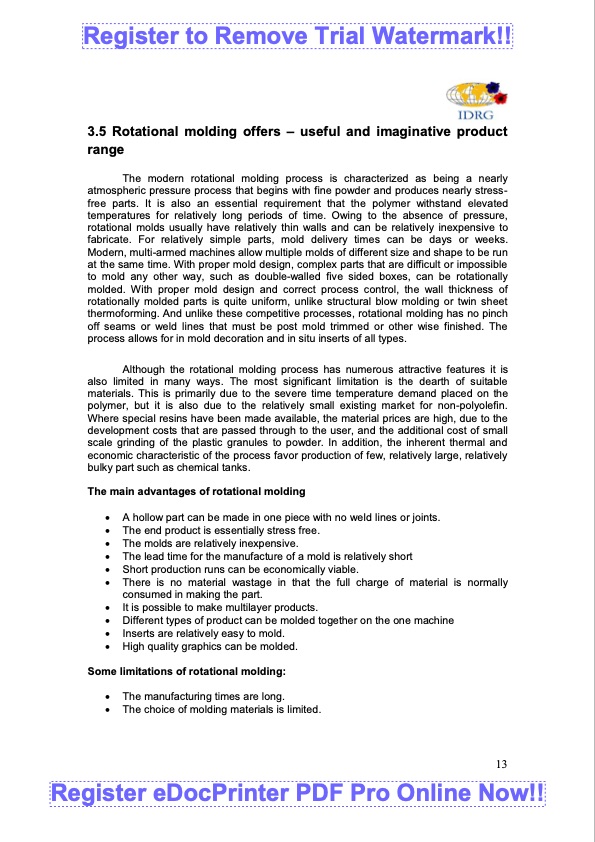
PDF Publication Title:
Text from PDF Page: 013
Register to Remove Trial Watermark!! 3.5 Rotational molding offers – useful and imaginative product range The modern rotational molding process is characterized as being a nearly atmospheric pressure process that begins with fine powder and produces nearly stress- free parts. It is also an essential requirement that the polymer withstand elevated temperatures for relatively long periods of time. Owing to the absence of pressure, rotational molds usually have relatively thin walls and can be relatively inexpensive to fabricate. For relatively simple parts, mold delivery times can be days or weeks. Modern, multi-armed machines allow multiple molds of different size and shape to be run at the same time. With proper mold design, complex parts that are difficult or impossible to mold any other way, such as double-walled five sided boxes, can be rotationally molded. With proper mold design and correct process control, the wall thickness of rotationally molded parts is quite uniform, unlike structural blow molding or twin sheet thermoforming. And unlike these competitive processes, rotational molding has no pinch off seams or weld lines that must be post mold trimmed or other wise finished. The process allows for in mold decoration and in situ inserts of all types. Although the rotational molding process has numerous attractive features it is also limited in many ways. The most significant limitation is the dearth of suitable materials. This is primarily due to the severe time temperature demand placed on the polymer, but it is also due to the relatively small existing market for non-polyolefin. Where special resins have been made available, the material prices are high, due to the development costs that are passed through to the user, and the additional cost of small scale grinding of the plastic granules to powder. In addition, the inherent thermal and economic characteristic of the process favor production of few, relatively large, relatively bulky part such as chemical tanks. The main advantages of rotational molding A hollow part can be made in one piece with no weld lines or joints. The end product is essentially stress free. The molds are relatively inexpensive. The lead time for the manufacture of a mold is relatively short Short production runs can be economically viable. There is no material wastage in that the full charge of material is normally consumed in making the part. It is possible to make multilayer products. Different types of product can be molded together on the one machine Inserts are relatively easy to mold. High quality graphics can be molded. Some limitations of rotational molding: The manufacturing times are long. The choice of molding materials is limited. Register eDocPrinter PDF Pro Online Now!! 13PDF Image | ANALYSIS OF ROTO-MOULDED PLASTIC CONTAINERS

PDF Search Title:
ANALYSIS OF ROTO-MOULDED PLASTIC CONTAINERSOriginal File Name Searched:
Construction-PART-3.pdfDIY PDF Search: Google It | Yahoo | Bing
Development of a solar powered Electric Ship The Electricship website originally started off as a project to develop a comprehensive renewable, affordable, modular electric ship... More Info
Modular Boat Hull Composite The case for a unsinkable, modular composite hybrid boat hull... More Info
MS Burgenstock Hybrid Electric Catamaran Lake Lucerne Unique shuttle servicing Lucerne to the Burgenstock Resort... More Info
Ground Power Unit GPU Powered by Lithium Ion Batteries The goal of the Ground Power Unit is to provide a readily accessible, modular, ready-to-power solution for remote power... More Info
| CONTACT TEL: 608-238-6001 Email: greg@electricship.com | RSS | AMP |